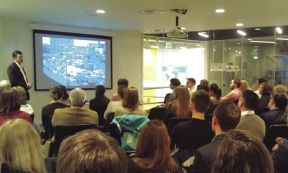On January 8th, students from Greater Boston came together at BSA Space to share some of their recent transportation design work. The event capped a multi-month academic initiative for the new Rights of Way exhibition and ongoing overhaul: The 2013/2014 transportation series. A call was put out last summer for students to relay their material and a diverse collection of projects was submitted, jury-reviewed, and included in the exhibit.
The projects delved into unique aspects of transportation design, such as the architectural and urban design implications of MIT's CityCar/Hiriko, converting the Old Northern Ave. Bridge into an inhabitable pedestrian link, streamlining the city's Long Wharf water transit service, and contending with underutilized parcels above the Central Artery and Mass Pike. The schemes examined the application of new technology and urban reform. Each project, from single-block developments at Dewey Square to communities in New Bedford and Providence along Greater Boston's rail network, contended with issues that remain open-ended after decades of advancement.
The city and region have pushed for a balance among automobiles, transit, biking, and pedestrian systems since the 1970s, when the Boston Transportation Planning Review was put into effect and advancements along the Orange and Red Lines, Mass. Pike, and Central Artery came to fruition. In the wake of these initiatives, however, property values continue to rise and every inch given to the automobile is now scrutinized.
Greater Boston still has lofty transportation ambitions but without the same levels of state and federal money to execute them, thus thinking practically and locally is key. For instance, the region cannot fund and construct a new subway extension from the Blue Line to the Red Line but can deal with the one-block gap under Washington Street that prevents riders from walking and transferring between the subway lines. The student submissions contended with similar scenarios across the region, creating designs that were both engaging yet pragmatic in the post-Central Artery/Tunnel era. The selected work showcased key proposals in a period of limited funding yet abundant unutilized infrastructure.
From more than 40 boards from seven different schools, a handful were selected for the academic exhibit. The work - from the Boston Architectural College, Northeastern University, Massachusetts College of Art and Design, Roger Williams University, Wentworth Institute of Technology, and the University of Massachusetts/Amherst - will be on display in the Harbor Room at BSA Space until May 26th, 2014.
By Nicholas Caruso / January 16, 2014
Reprinted from http://www.architects.org/news/and-around-boston
Tags:
Right of way: Mobility and the city exhibition and ongoing overhaul: The 2013/2014 transportation series
February 20, 2014 - Construction Design & Engineering
.png)







